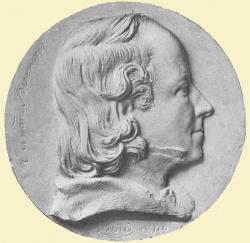Eugène Burnouf
Eugène Burnouf (April 8, 1801 – May 28, 1852) was an eminent French scholar and orientalist who made significant contributions to the deciphering of Old Persian cuneiform.
He was born in Paris. His father, Professor Jean-Louis Burnouf (1775-1844), was a classical scholar of high reputation, and the author, among other works, of an excellent translation of Tacitus (6 vols., 1827-1833). Eugène Burnouf published in 1826 an Essai sur le Pali ..., written in collaboration with Christian Lassen; and in the following year Observations grammaticales sur quelques passages de l'essai sur le Pali.
The next great work he undertook was the deciphering of the Avesta manuscripts brought to France by Anquetil-Duperron. By his research a knowledge of the Avestan language was first brought into the scientific world of Europe. He caused the Vendidad Sade, to be lithographed with the utmost care from the manuscript in the Bibliothèque Nationale, and published it in folio parts, 1829-1843.
From 1833 to 1835 he published his Commentaire sur le Yaçna, l'un des livres liturgiques des Parses.
At about the same time in his life, Eugène Burnouf made significant contributions to the decyphering of Old Persian cuneiform. Copies of cuneiform inscriptions from Persepolis had been published by Carsten Niebuhr many years earlier in 1778 and some preliminary inferences had already been made by other scholars about these Persian inscriptions. In 1836, Eugène Burnouf discovered that the first of the inscriptions contained a list of the satrapies of Darius. With this clue in his hand, he was able to identify and publish an alphabet of thirty letters, most of which he had correctly deciphered.
A month earlier, Burnouf's friend Professor Christian Lassen of Bonn, had also published a work on "The Old Persian Cuneiform Inscriptions of Persepolis". He and Burnouf had been in frequent correspondence, and his claim to have independently detected the names of the satrapies, and thereby to have fixed the values of the Persian characters, was in consequence fiercely attacked. However, whatever his obligations to Burnouf may have been, according to Sayce, Lassen's "contributions to the decipherment of the inscriptions were numerous and important."
A year later in 1837, Henry Rawlinson had made a copy of the much longer Behistun inscriptions in Persia . Carved in the reign of King Darius of Persia (522 BC–486 BC), the inscriptions consisted of identical texts in the three official languages of the empire: Old Persian, Babylonian, and Elamite. Rawlinson sent a translation of the opening paragraphs to the Royal Asiatic Society. Before, however, his Paper could be published, the works of Lassen and Burnouf reached him, necessitating a revision of his Paper and the postponement of its publication. Then came other causes of delay. In 1847 the first part of the Rawlinson's Memoir was published, the second part did not appear till 1849. The task of deciphering the Persian cuneiform texts was virtually accomplished.
Eugène Burnouf published the Sanskrit text and French translation of the Bhagavata Purana ou histoire poétique de Krichna in three folio volumes (1840-1847). His last works were Introduction à l'histoire du Bouddhisme indien (1844), and a translation of Le lotus de la bonne loi (The Lotus Sutra, 1852). He had been for twenty years a member of the Academie des Inscriptions and professor of Sanskrit in the Collège de France.
See a notice of Burnouf's works by Barthélemy Saint-Hilaire, prefixed to the second edition (1876) of the Introduction à l'histoire du Bouddhisme indien; also Naudet, Notice historique sur MM. Burnouf, père et fils, in Mémoires de l'Académie des Inscriptions, xx. A list of his valuable contributions to the Journal asiatique and of his manuscript writings, is given in the appendix to the Choix de lettres d'Eugène Burnouf (1891).
Works
Essai sur le Pali (1826)
Vendidad Sade, l'un des livres de Zoroastre (1829-1843)
Commentaire sur le Yaçna, l'un des livres liturgiques des Parses (1833-1835)
Mémoire sur les inscriptions cunéiformes (1838)
Bhâgavata Purâna ou histoire poétique de Krichna (3 volumes, 1840-1847)
Introduction à l'histoire du Bouddhisme indien (1844 ; 1876)
Le Lotus de la bonne loi, traduit du sanscrit, accompagné d'un commentaire et de vingt et un mémoires relatifs au buddhisme (Paris, Imprimerie Nationale, 1852). Reprint: Librairie d'Amérique et d'Orient A. Maisonneuve, Paris, 1973.
Eugène Burnouf on French Wikisource
